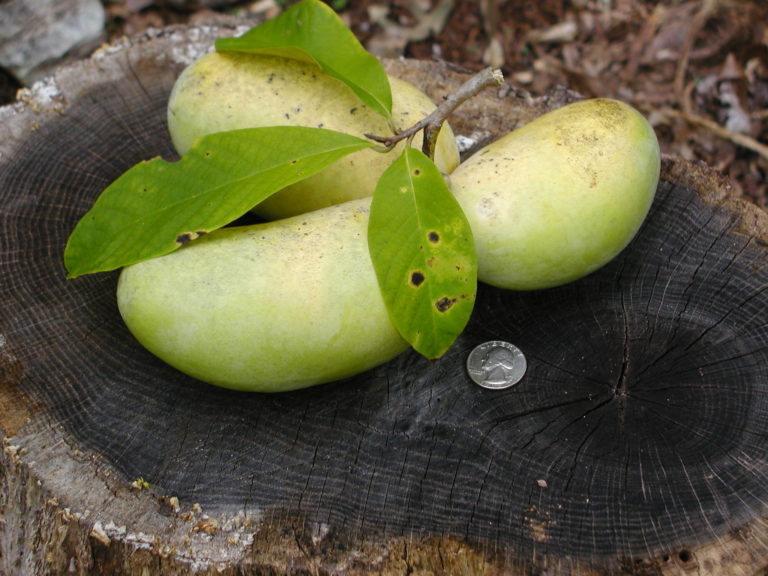The Pawpaw is a fun little tree (25-35 feet) to cultivate. In a favorable place, it will send out rhizomes and colonize. In spring there are lovely, dark red flowers emerging just as the leaves begin to unfurl. If there is another genetically distinct individual nearby, these flowers will give rise to the wonderful yellow-fleshed fruits. The fruit of the Pawpaw are prized by many small mammals as well as by people. Be warned: some people have a poor reaction (nausea) to the fruit. The colonizing root sprouts are easily controlled in this species, and should not deter a person from having at least one or two of them. They contribute to the beauty of the garden in the fall, with their large, rather floppy, tropical-looking leaves turning strong, bright golden before dropping. When scouting for seeds, we go to the patches of Pawpaw on the floodplain of the Haw River and shake trees with stems large enough to indicate that the tops are in the sun — the key to fruit production. Pawpaw is a larval host for the Zebra Swallowtail and the Pawpaw Sphinx butterflies, and the fruit is popular with all manner of small animals.
NURSERY HOURS
Wednesday: 10-4 Thursday: 10-6 Friday-Saturday: 10-4 Sunday: 12-4
Asimina triloba

Key Info
Scientific Name: Asimina triloba L.
Common Names: Paw Paw, Indian Banana, Poor Man's Banana, Prairie Banana, Hoosier Banana
Family Names: Annonaceae (Custard Apple Family)
Plant Type: Tree / Shrub
Leaf Retention: Deciduous
Flower Color: Maroon
Special Characteristics: Tolerates shade, Attracts butterflies, Good fall color, Edible fruit (in jams), Rhizomatous
Additional Info
Habit: Grown in the sun, the tree is shorter, and foliage is dense and will droop to the ground. In shade, the tree is taller and the canopy more open. Tap root is deep and roots are delicate, lacking in root hairs, and easily damaged in attempts to transplant. Can be grown multi-stemmed.
Height: 15'-35'
Spread: 15'-30'
Soil Conditions: Prefers moist (not wet), well drained soils in a range of types, loamy, sandy, clay; pH slightly acid to slightly alkaline;
Leaves: Large (6-12 inch), simple, untoothed, wider above the middle, with pointy tip and pinnately veined; conspcuously golden in fall; unpleasant odor if torn.
Flowers (or reproductive structures: Flowers are borne singly in leaf axils before leaves emerge, 1-2" flowers with 6 dark red/purple petals, 3 green sepals; not very fragrant.
Fruit: The edible paw paw fruit can be small to large (6"), oblong, with green to yellow skin (brown when ripe), yellow, custard-like flesh. Ripens in September.
Natural Distribution: Creek bottoms, ditches and ravines, floodplains
USDA Hardiness Zone: 5 to 9
USDA Wetland Indicator Status in NC: FAC
Pollination: Carrion flies, blowflies and beetles; Pawpaw must be cross pollinated. Trees in a colony are more likely clones and not suitable for cross pollination.
Wildlife Connections: Larval host for the Zebra Swallowtail and the Pawpaw Sphinx; deer don’t eat the leaves but they love the fruit, as do squirrels, raccoons and opossums.
Propagation: By seed.
